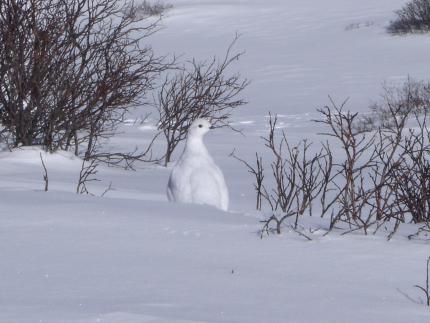High
The greatest threat to the long-term survival of white-tailed ptarmigan populations appears to be climate change, which may lead to a gradual loss of alpine habitats as the tree line moves upward.
Description and Range
Physical description
The white-tailed ptarmigan is about 12 inches long. They have white plumage in winter; males have a red eye comb. In summer, the body is mottled brown or black with white on the tail, belly, and wings.
Ecology and life history
White-tailed ptarmigan dwell mostly on the ground in alpine tundra habitats. They depend on alpine tundra habitats that are forb-rich with occasional shrubs such as willow.

They are generally resident in the same habitats throughout the year but some birds may migrate to lower elevations in winter.
During winter they may spend time feeding on vegetation in wind-exposed areas, avalanche chutes, and riparian areas with exposed shrubs.
They are monogamous and the breeding pair defends a territory during the breeding and nesting seasons. Females generally produce a clutch of five to seven eggs. Nest and brood success are usually not very high, but these are compensated for with relatively high survival.
Geographic range
White-tailed ptarmigan are distributed in alpine tundra habitats of western North America. In Washington they are found in the Cascades from Mt. Adams north to the U.S.-Canada border.
There has been little work done with white-tailed ptarmigan, but birds are believed to be relatively rare on Mt. Adams and common in areas further north, such as the Pasayten Wilderness. There is an apparent gap of about 31 miles in occupancy between Mt. Rainier and the Alpine Lakes Wilderness to the north.
Climate vulnerability
Sensitivity to climate change
High
Physiological sensitivity of white-tailed ptarmigan is likely low-moderate as this species is well-adapted to high altitude climatic variation and harsh conditions, although it has been shown that high winter minimum temperatures can retard population growth rates. The sensitivity of this species will primarily be driven by its dependence on high elevation habitats likely to be reduced in quality and abundance due to climate change, as well as its dependence on deciduous shrubs and trees for foraging.
Exposure to climate change
High
- Increases in winter minimum temperatures
- Increased temperatures overall
- Reduced snowpack
Conservation
The subspecies found in Washington State is federally listed as a threatened species. This species is also identified as a Species of Greatest Conservation Need (SGCN) under the State Wildlife Action Plan (SWAP). SGCN-classified species include both those with and without legal protection status under the Federal or State Endangered Species programs, as well as game species with low populations. The WDFW SWAP is part of a nationwide effort by all 50 states and five U.S. territories to develop conservation action plans for fish, wildlife and their natural habitats—identifying opportunities for species' recovery before they are imperiled and more limited.
Conservation Threats and Actions Needed
- Education needs
- Threat: Outreach for the general public to educate them about white-tailed ptarmigan and the risks they face
- Action Needed: Improved outreach about ptarmigan.
- Resource information collection needs
- Threat: Little known about abundance and connectivity in Washington.
- Action Needed: Research and baseline monitoring needed to help develop and target effective management.
- Climate change and severe weather
- Threat: Low elevation habitats influenced by indirect impacts of climate change due to drier conditions, longer growing seasons, and encroachment by trees.
- Action Needed: Continue to minimize human disturbance (direct and indirect) in white-tailed ptarmigan habitats.
See the Climate vulnerability section for more information about the threats posed by climate change to this species.
Resources
References
Martin, K., Robb, L. A., Wilson, S., & Braun, C. E. (2020). White-tailed Ptarmigan (Lagopus leucura), version 1.0. In P. G. Rodewald (Ed.), Birds of the World. Cornell Lab of Ornithology.
USFWS (U.S. Fish and Wildlife Service). 2012. Endangered and threatened wildlife and plants; 90-day finding on a petition to list the southern white-tailed ptarmigan and the Mt. Rainier white-tailed ptarmigan as threatened with critical habitat. Federal Register 77:33143–33155.
USFWS (U.S. Fish and Wildlife Service). 2023. Species Status Assessment for Mount Rainier White-tailed Ptarmigan (Lagopus leucura rainierensis) Version 2. Washington Fish and Wildlife Office, Lacey, Washington. Available at https://ecos.fws.gov/ecp/species/9234
USFWS (U.S. Fish and Wildlife Service). 2024. Endangered and Threatened Wildlife and Plants; Threatened Species Status for Mount Rainier White-Tailed Ptarmigan With a Section 4(d) Rule. Federal Register 89(128):55091–55113.